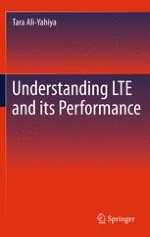2011 | OriginalPaper | Buchkapitel
Fractional Frequency Reuse in LTE Networks
verfasst von : Tara Ali-Yahiya
Erschienen in: Understanding LTE and its Performance
Verlag: Springer New York
Aktivieren Sie unsere intelligente Suche, um passende Fachinhalte oder Patente zu finden.
Wählen Sie Textabschnitte aus um mit Künstlicher Intelligenz passenden Patente zu finden. powered by
Markieren Sie Textabschnitte, um KI-gestützt weitere passende Inhalte zu finden. powered by
LTE supports Orthogonal Frequency Division Multiple Access (OFDMA) communication system where frequency reuse of one is used, i.e. all cells/sectors operate on the same frequency channel to maximize spectral efficiency. However, due to heavy
Co-channel Interference (CCI)
Cochannel interference (CCI)
in frequency reuse one deployment, UEs at the cell edge may suffer degradation in connection quality. With LTE, UEs operate on subchannels, which only occupy a small fraction of the whole channel bandwidth; the cell edge interference problem can be easily addressed by appropriately configuring subchannel usage without resorting to traditional frequency planning.
Resource allocation in multi-cell OFDMA networks has been developed in several works using
Fractional Frequency Reuse (FFR)
Fractional frequency reuse (FFR)
. However, only few contributions have explicitly taken into account the nature of application being either real time or non-real time. For example, authors in [1,2] proposed dynamic resource allocation scheme for guaranteeing QoS requirements while maximizing the whole throughput of the system. However, both schemes work only for non-real-time application. Qi and Ali-Yahiya [3,4] introduced the
Radio Network Controller (RNC)
Radio network controller (RNC)
to control a cluster of Base Station (eNodeBs) in the multi-cell OFDMA system and to allocate resources in a distributed way; however, these schemes allocate resources in the RNC without taking into account the reallocation scheme at each eNodeB for coordinating resource according to the FFR. Authors in [5] proposed a local resource allocation the eNodeBs in a random way without taking into consideration the RNC. Thus the eNodeB has not a global view about the adjacent cells in the system, leading to inefficient resource allocation.
